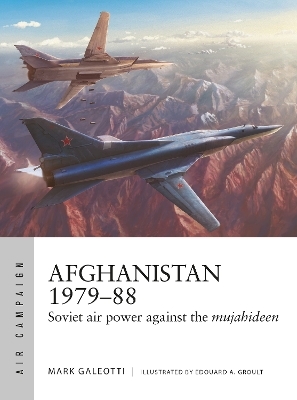
Afghanistan 1979–88
Osprey Publishing (Verlag)
978-1-4728-5071-3 (ISBN)
The Soviet Union’s invasion of Afghanistan was fought as much in the air as on the ground. From the high-level bombing raids that blasted rebel-held mountain valleys, to the Mi-24 helicopter gunships and Su-25 jets that accompanied every substantial army operation, Soviet control of the air was a crucial battlefield asset. Vital to every aspect of its operations, Mi-8 helicopters ferried supplies to remote mountain-top observation points and took the bodies of fallen soldiers on their last journey home in An12 ‘Black Tulips’.
But this was not a wholly one-sided conflict. Even before the Afghan rebels began to acquire man-portable surface-to-air missiles such as the controversial US ‘Stinger,’ they aggressively and imaginatively adapted. They learnt new techniques of camouflage and deception, set up ambushes against low-level attacks, and even launched daring raids on airbases to destroy aircraft on the ground.
Featuring information previously unknown in the West, such as the Soviets' combat-testing of Yak-38 'Forger' naval jump jets, Soviet-expert Mark Galeotti examines the rebel, Kabul government and the Soviet operation in Afghanistan, drawing deeply on Western and Russian sources, and including after-action analyses from the Soviet military. Using maps, battlescenes and detailed 'Bird's Eye Views', he paints a comprehensive picture of the air war and describes how, arguably, it was Soviet air power that made the difference between defeat for Moscow and the subsequent stalemate that they decided to disengage from.
Professor Mark Galeotti runs the Mayak Intelligence consultancy and is also an Honorary Professor at UCL, a Senior Associate Fellow with RUSI and a Senior Non-Resident Fellow at the Institute of International Relations Prague. Formerly Head of History at Keele University in the UK and Professor of Global Affairs at New York University, he is a former Foreign Office adviser on Russian security affairs, and for 15 years (1991–2006) wrote a monthly column on this for Jane's Intelligence Review. Mark's most recent books for Osprey are NVG 282 Combat Vehicles of Russia's Special Forces and ELI 228 Armies of Russia's War in Ukraine.
INTRODUCTION
Flying in an Afghan summer
CHRONOLOGY
ATTACKER'S CAPABILITIES
The Soviet Air Force in Afghanistan
Close air support
Bombing
Airlift
Supporting the war
The DRA Air Force
DEFENDER'S CAPABILITIES
Countering Soviet air power
Deception, evasion and camouflage
Anti-aircraft artillery
MANPADS
Mines and ambushes
Raids
CAMPAIGN OBJECTIVES
A decade in Afghanistan
1. Invasion, 1979–80
2. Reluctant escalation, 1980–84
3. Chernenko’s war, 1984–86
4. The ‘bleeding wound’, 1986–88
5. Withdrawal, 1988–89
THE CAMPAIGN
Jets and helicopters fight a guerrilla war
1. Invasion, 1979–80
2. Reluctant escalation, 1980–84
Operation Rhombus and the Yak-38
3. Chernenko’s war, 1984–86
Operation Trap: The end of ‘Chernenko’s war’
4. The ‘bleeding wound’, 1986–88
The Stinger
Operation Highway, 1987–88
5.Withdrawal, 1988–89
Operation Air-Bridge, January–February 1989
AFTERMATH AND ANALYSIS
FURTHER READING
GLOSSARY
INDEX
| Erscheinungsdatum | 02.02.2023 |
|---|---|
| Reihe/Serie | Air Campaign |
| Illustrationen | Edouard A. Groult |
| Zusatzinfo | Includes around 60 photos and at least 14 pages of colour illustrations |
| Sprache | englisch |
| Maße | 184 x 248 mm |
| Themenwelt | Geschichte ► Allgemeine Geschichte ► Neuzeit (bis 1918) |
| Geschichte ► Teilgebiete der Geschichte ► Militärgeschichte | |
| Sozialwissenschaften ► Politik / Verwaltung | |
| ISBN-10 | 1-4728-5071-8 / 1472850718 |
| ISBN-13 | 978-1-4728-5071-3 / 9781472850713 |
| Zustand | Neuware |
| Haben Sie eine Frage zum Produkt? |
aus dem Bereich


